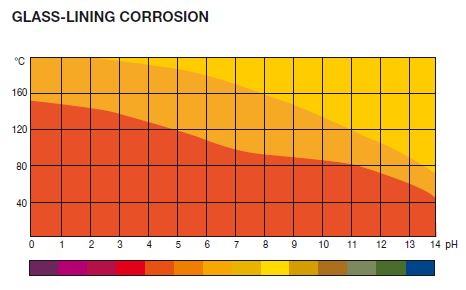Glass lined Reactor is a pressure vessel which has main body made with carbon steel and lined with glass.
Glass lined Reactor is used to handle highly corrosive materials.
This reactor is available in
- One piece configuration
- Separate 2 piece of
A. Vessel and B. Agitator
Properties of Glass
Glass is lined in reactor vessel with Borosilicate 3.3
Borosilicate Glass 3.3 compositions
- 80% Silica
- 13% Boron oxide
- 4% Sodium Oxide
- 2 - 3% Aluminium Oxide
Boron oxides thermal expansion is very low.
Borosilicate 3.3 glass has low weight density because atomic weight of
Boron is low.
It is 10.81 g/mol.
Check other properties
Thermal expansion means
Change in tempreture will change substance shape, area, volume, and density.
If Glass has...
High Thermal expansion → More possibility to failure of Glass lining.
Low Thermal expansion → Long life of Glass lining
Main Parts of Reactors are
1. Reactor Vessel
2. Agitators
3. Jackets for Cooling and heating
4. Instrumentation
5. Gearbox and motor
1. Reactor Vessel
It is reaction vessel which are generally in shapes of
- Vertical capsule
- Flat bottom
- Conical bottom
- Modified as per required
2. Agitators
3. Heating Cooling Jackets
4. Instrumentation
Instrument clusters
- Pressure Transmitter
- Temperature Transmitter
- Flow Transmitter etc
5. Gearbox and Motor
Glass lining is available in various colours but main 4 colours are popular.
1. Blue
2. Light blue
3. White
4. Green
Each glass has different property and application.
1. Blue Glass lining
Dark blue colour is used in high concentrated acids and bases.
It provides maximum protection against concentrated acids and bases.
2. Light Blue Glasslining
Light blue Glasslining Reactor used in Pharmaceutical industry
This colour has better optical monitoring.
Corrosion resistance is low compared to Dark blue colour.
3. White Glass lining
White Glass lining is used for that types of Processes in which colours are changing in process.
Accurate monitoring on colour can be possible.
4. Green Color Glass lining
Green colour glass lining is used to handle reactions carried at high temperatures.
Maximum temperature handle in green glass lined Reactor is 270℃
Impacts of Chemicals
Highly alkaline solutions with high temperature has highest corrosion
We can see graph Glass Lining Corrosion graph Temperature vs pH
Excellent resistance to corrosion
Variable effect depends on actual process
Highest corrosion in glass not recommended
HCl
- If HCl is using in liquid phase in glasslined reactor it will erode 0.01mm / year.
- HCl in Vapour phase corrode 0.04 mm/year.
NaOH
- NaOH is erode 0.21 mm/year.
Water
- Water erodes 0.008 mm/year in liquid phase.
- Water vapour erodes 0.013 mm/year.
Erosion is increasing with increase in batch volume and fluid velocity in reactor.
We can see in below graph that corrosion is minimum up to 150℃.
Corrosion is increasing with in increasing temperature and alkaline pH.
We can see general Acid base vs Volume below
Thermal shock in Glass
When heating or cooling applied in Glasslined Reactor - temperature difference between reactor inner fluid and heating or cooling should not high.
High difference between inner fluid temperature and heating or cooling source will be damaged due to thermal shock.
Graph 1: Reactor inner fluid temperature vs Heating source temperature.
Graph 2: Reactor inner fluid temperature vs Cooling source temperature.
We can How much temperature difference maximum allowable.
Examples of Glass lining failure
Glass lining side
1. If Glass lined wall temperature is 10°C
Then fluid inner temperature should be 160°C
2. When Reactor inner temperature is 180°C then Cooling source temperature must above 50°C.
3. When Reactor inner temperature is 0°C then heating source temperature must below 140°C.
4. When Reactor inner temperature is 20°C then heating source temperature must below 170°C.
Physical Characteristics of Glass lining
Corrosion resistance of Glass lining with different chemicals at different temperatures
1. Hydrofloric acid and Floride aqueous solutions can not give resistance to corrosion of glass lining even at 50°C and corrosion is highest.
2. Triethylamine is not corrosive at 50°C temperature and higher corrosive at 100°C
We can see chemicals list at below
Typical Glass Failure
1. Mechanical shock
Mechanical shock is 75% reason for glass failure
- Impact due to heavy object fall on reactor
- Object fall in reactor. Example: Bolt or metallic parts, stones etc.
- Improper support and heavy vibration.
- Wrong impeller direction and over torque.
2. Acid attack
Hydrofloric acid and Phosphorus acid with 85% Concentration corrodes glass lining maximum.
Rest Chemicals chart as seen above.
3. Abrasion
Chemical process in Glass lined Reactor with
- High viscous chemicals
- Slurry
- Solid particles contained chemicals reactions
Rubbing surface of glass lining of reactor and making rough like sand paper.
This rubbing breaks silica network and boosting corrosion of glass lining.
4. Thermal shock
We already discussed this topic above.
5. Electrostatic discharge failure
When two components mixed together then they transfer electron and generates static charge.
When proper static is not discharged static accumulation takes place. This static is discharge with pinhole of crack. This damage is continuously damage more glass lining.
Static charge generation can be reduced by
- Adding water or quick solvent.
- Reduction in agitation.
- Adding dip lines for chemical dosing and Avoiding free flow of Chemicals
- Proper grounding of Chemical mixture and Reactor.






















